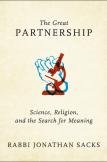No Need to Argue
Sir Jonathan Sacks is the retired chief rabbi of Britain and the Commonwealth. One of the world’s foremost English-speaking intellectuals, Sacks has published a variety of important books on contemporary social ethics. After the terrorist attacks in the United States on Sept. 11, 2001, he produced a thoughtful and insightful treatment of the value of diversity in pluralistic societies, The Dignity of Difference: How to Avoid a Clash of Civilizations. After the bombings in London on July 7, 2005, Sacks argued in The Home We Build Together that we must move beyond the social fractures of multiculturalism by strengthening covenantal politics, civil society and civic virtue.
Sacks’s The Great Partnership continues this concern with public life in terms of the relation between science and religion. The author is concerned with the negative public impact that has been exerted by the “new atheists,” like Richard Dawkins. Sacks believes that "the major assault on religion today comes from the neo-Darwinians." We are framed by two extremes: a modern scientism that regards science as the sole arbiter of truth on the one hand, and fundamentalist reaction on the other. The former is associated with ontological naturalism that generates moral relativism, and the latter advances forms of moral absolutism that inspire fanaticism. Both extremes claim to be the only perspective from which one can accurately view the world.
The Great Partnership proposes that we move beyond the culture war between these mutually exclusive positions by learning to appreciate the value of intellectual pluralism while affirming the unity of human knowing. It seeks to distinguish in order to unite. Instead of buying into the dominant conflict model of the relation of religion and science, the author mounts a lengthy argument to show that core elements of our Western tradition give us ample resources for seeing them as partners. Each has its own distinctive area of competence: religion searches for meaning, science for explanation; religion is defined by stories, science by theories; religion seeks synthesis, science analysis of component parts. These intellectual differences can be understood as complementarities.
The argument proceeds in three major steps. First, Sacks makes a historical argument that the perceived antagonism of science and religion comes from the way that Christianity attempted to combine Greek and Hebrew cultures. The attempt to fuse the god of the Greek philosophers and the God of the patriarchs led to profound confusion about the very nature of religion. This aspect of Sacks’s argument will be the most challenging to Catholic readers who believe that theology can be enriched and deepened by philosophy. Sacks argues that the Christian appropriation of abstract Greek concepts eventually led to the inference that since modern science discredited Aristotelian science, it also discredited the religion onto which it had been grafted. We can help to re-establish the proper sphere of religion by disentangling it from the explanatory domain of science.
Second, Sacks offers an extended argument for why faith matters. Monotheism has provided the religious foundation of the moral values that lie at the core of Western culture: the dignity of the person as made in the image of God, the moral limits of political power, individual moral responsibility, the centrality of marriage and family and a vision of life as meaningful. Secular thinking does not provide any substantive backing for these values, so their hold over us will continue to decay if religion continues to weaken. Sacks insists that only faith in God, the transcendent origin of goodness, calls us out of ourselves in a way that frees us from the “prison of the self.”
Third, Sacks addresses the major challenges to faith today. In response to the neo-Darwinian charge that faith makes no sense in a world pervaded by chance, he argues that a more complex notion of “design” that works in and through the interplay of law-like regularities and chance allows for the guidance of divine providence. In response to those who doubt that a good and all-powerful God could have created a natural world so marked by waste and suffering, he argues that faith calls us to recognize that evil is a mystery rather than a problem to be solved. A faith rooted in the prophets ought to motivate us both to protest our collective human role in unjust suffering as well as to dedicate ourselves to repairing the world.
Nowhere does Sacks suggest that we ought to recover our appreciation for faith because religion is unambiguously beneficial for any society. Religion can be a great force for good, but also, when it goes bad, a terrible force for evil. Given its history as an oppressed minority religion in Christendom, Judaism is particularly well attuned to the evil that can be done in the name of religion. When monotheism is corrupted into dualism, it tends to reinforce an “us-them” mentality that leads to exclusion and destruction. All the more reason, then, to recover monotheism’s sense that for an inclusive meaning under the one Creator.
Sacks’s The Great Partnership makes an excellent case for its claim that the differences between science and religion need not make them enemies. It will not instantly convert all of the “new atheists,” but it does develop a perspective from which one can imagine the possibility of living as an intellectually serious person of faith in a culture that is increasingly shaped by the sciences.
This article also appeared in print, under the headline “No Need to Argue,” in the August 12-19, 2013, issue.








